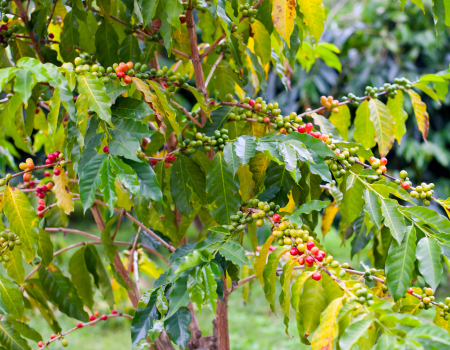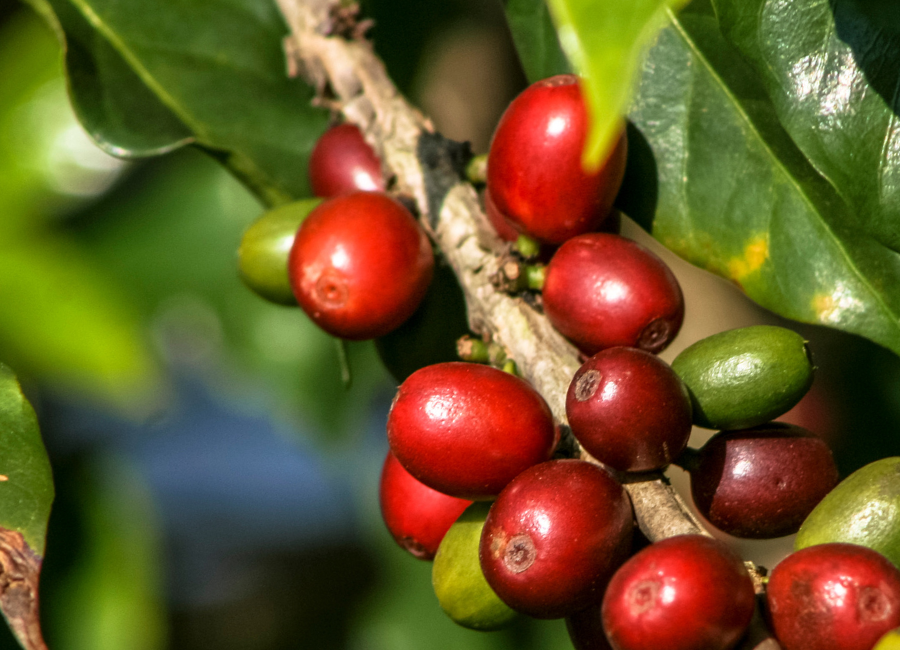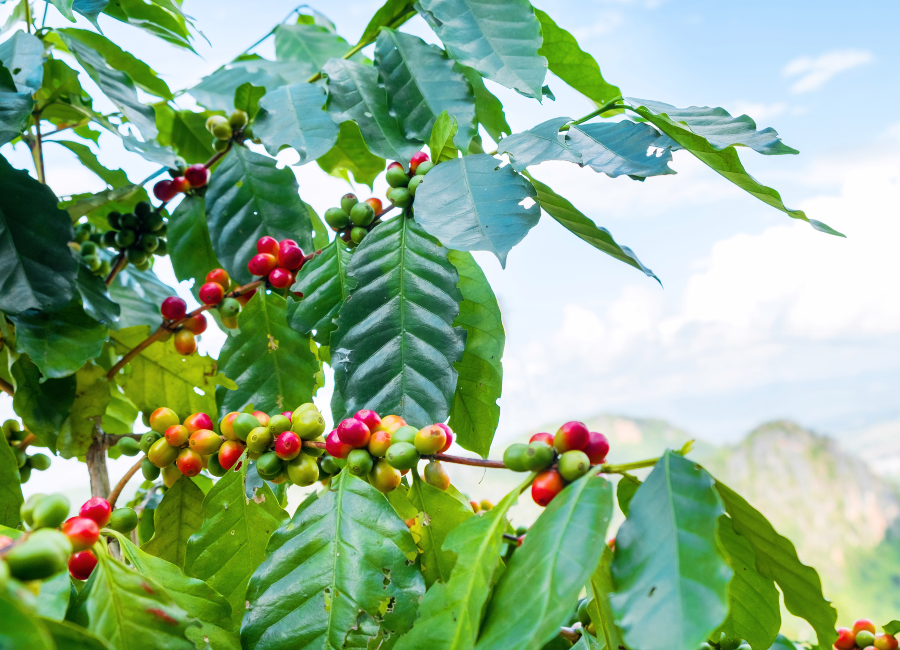Coffee Tree: Everything For Care

The coffee tree is an evergreen plant growing from 2 to 8 meters. It has white, sweetly fragranced flowers and shiny green leaves. Although the fruits are primarily red, they can also be purple or yellow. The fruit has two seeds, called coffee beans. Let's learn about growing coffee trees.
Fast Facts for the Coffee Tree
| Common Name | Coffea arabica tree, coffee tree |
|---|---|
| Scientific Name | Coffea arabica, Coffea canephora |
| Harvest | October through December |
| Light | Require indirect light for a few hours daily |
| Water | Require watering once every week or every other week |
| Soil | Thrive in a peat-based, rich, acidic soil |
| Fertilizer | Need a nitrogen-rich fertilizer; citrus and rose fertilizers work best |
| Pests | Susceptible to attack by the scale insect, aphids, wood boring beetle, coffee berry borer, and mealybugs |
| Diseases | Prone to coffee leaf rust, black rot, berry blotch, and brown eye spot disease |
| Growing Zone | 10 to 11 |
Table of Contents
Everything You Need to Know to Take Care of Coffee Tree

Although there are well over 100 species of the coffee plant, we only cultivate Robusta and Arabica. You can choose any of the two species and follow these instructions to grow a tree of coffee.
Planting
The coffee tree grows from April to August. You should plant the coffee bean tree before April, giving it some time to adjust to the soil. You can find seeds or seedlings from a store or online.
Plant the tree outside in Zone 10 to 11. Alternatively, you can let the seedlings grow in a pot and transplant the coffee bean tree to the ground after it has grown extensive roots.
Since coffee trees grow wide, keep a distance of 3 or more feet from adjacent trees when planting the seed. Here's how to plant a coffee seed:
- Plant the seed in fertile and acidic soil.
- Water the soil.
- Fertilize the soil about three times per year for the first few years.
- Replace the pot with a bigger one if the plant outgrows it.
Care and Maintenance
If you care well for coffee plants, they flower in about 4 to 5 years. Here's how to care for the plant.
Sun and Temperature
Coffee plants do not like direct sunlight. If you plant the tree outside, make sure it's in partial shade. Indoor planters should be placed near a south-facing sunny window.
The ideal temperature for coffee plants is between 60 and 80°F. If the temperature drops to 55°F or lower, the plant may start dropping its leaves.
Water and Humidity
Water once a week to keep the soil moist. Coffee plants do not like to be overly wet since it can lead to root rot. Reduce the watering frequency in winter.
Being a tropical plant, the coffee tree won't mind high humidity. But if you've planted it in a pot, do not keep the pot near a heater or heating vent, as it may dry out the plant.
Soil
The best type of soil for a coffee tree is rich in organic matter and slightly acidic. The pH should be anywhere from 6 to 6.5. If the soil isn't well-draining, add perlite or sand to improve drainage. Similarly, if it's not acidic enough, increase the acidity by adding peat moss or sulfur.
Fertilizing
Fertilize the coffee tree with a nitrogen-rich fertilizer in the growing season, which is in spring and summer. Look for a fertilizer that also contains micronutrients, such as boron, calcium, zinc, and sulfur. Use citrus or rose fertilizers for the best results.
Pruning
Many growers like to prune their coffee plants to keep them at a height of 6 feet since harvesting fruit from tall trees can be complicated and tedious.
Keeping your tree at this height would require annual pruning. You can prune the tree whenever you want, but it's best to do it during spring. When pruning, do not remove over 1/3rd of the foliage.
The key is to remove the secondary branches from the tree. If it also has tertiary branches, start removing them first. Leave the primary branches intact so that growth continues.
Propagation
Seeds are most commonly used for coffee propagation. You can get arabica or robusta beans from their respective plants. Wash the seeds and put them in water for a full day.
Remove them from the water and put them in well-drained soil. Let them germinate. Once you see the first leaves, transplant them into bigger pots. The viability of these seeds is up to four months, although older seeds are less likely to germinate.
Harvesting and Storing
The number of fruits a coffee plant produces will depend on the plant's health. However, one plant doesn't produce enough fruit to make a full coffee pot. That's why it's better to grow multiple plants.
Harvesting
The tree's plant is called the coffee cherry, which is dark red in color. Coffee cherries stay on the tree and have to be removed by hand. You can also eat the coffee cherry itself. It has a grape-like flavor. To get the coffee beans, cut the cherry with a knife and remove the two seeds inside.
Storing
To store coffee beans, you need to roast them. It's a lengthy process that involves fermenting and drying the seeds. Roasted coffee beans can stay fresh in an airtight container for months. You can also freeze them, but it will slightly change the flavor.
Did you know? Brazil produces the most coffee in the world [1]. It is followed by Vietnam and Colombia in coffee production.
Common Issues With Coffee Trees

It's important to keep an eye on your coffee tree to identify any diseases or growing problems early on.
Growing Problems
Coffee plants need high humidity due to their tropical nature. If you notice the leaves getting brown, it's a sign the plant is not getting enough humidity. Move the plant to a more humid area or use a humidifier to increase the humidity.
Pests
Different coffee species attract different pests. Fortunately, robusta plants do not attract many pests due to their high caffeine content.
Arabica plants can be attacked by nematodes. These worms damage the plant's roots, resulting in yellow and wilting leaves.
Mealybugs also affect coffee plants as they feed on the leaves. Your plant will wilt initially and then die over time. Rubbing alcohol can help manage mealybugs. Or you can use an insecticidal soap to get rid of the bug population.
Diseases
Coffee leaf rust is a fungal disease that can affect your plant's leaves. It starts with yellow spots, which later turn into red or orange spores. Use a copper-containing fungicide to treat your plants.
The coffee berry disease affects coffee cherries, causing them to drop. A copper fungicide can help in this regard too.
Berry blotch is another fungal disease that causes dark spots on the cherries. It is caused by Cercospora coffeicola, a fungal pathogen. Prune the affected branches and use a fungicide to manage the disease.
FAQs
Before you go...
Now that you know how to take care of coffee trees, you might be interested in some other plant care guides. Be sure to check out our other guide on the pluot tree so you can learn more about unique things to garden...
Related Articles:

Christina Hernandez
Christina has done most of her research on environmental science but recently has changed her focus towards sustainable forestry. She has a passion for the outdoors and wants to spread that passion to the world.
Join our community!
Join to receive guides, insights, and the latest gardening deals!
